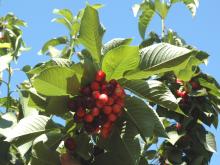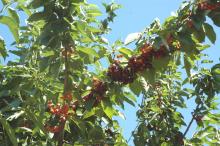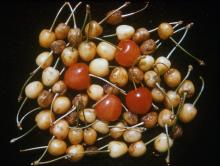See:
Cherry (Prunus spp.) - Little Cherry
Cherry Cultivar Susceptibility
Cause A phytoplasma sometimes called cherry buckskin in California or albino in Oregon. Candidatus Phytoplasma pruni is the suggested scientific name for the X disease phytoplasma. Several strains have been identified based on molecular analysis including those named Eastern-X, Western-X, and Northwestern-X1 through -X3 and two more on chokecherry. They seem to differ in symptomology, geographic location and possible vectors, but more research is needed to tease out these aspects.
X-Disease can be transmitted by budding or grafting, but because the disease is unevenly distributed in the tree, a fair number of buds will not carry the organism. Bud wood held in storage frequently will not transmit the disease. The organism can also spread from an infected tree to a healthy tree through natural root grafts. Leafhoppers spread the organisms in the orchard; Colladonus geminatus and C. reductus are the most common vectors. Leafhoppers positive for the X phytoplasma are most active in the spring and late summer into fall. There is a 1-month latent period between leafhopper acquisition from diseased trees and transmission to healthy trees. Attempts to control the disease's spread with insecticides for leafhopper control have been unsuccessful. Infected trees may not show symptoms for two years but can still be a source of inoculum for healthy trees during that time. There are two distinct stages of infection with an early stage characterized by low titer corresponding to mild or no symptoms and an establishment stage that corresponds to high titer, systemic virus distribution and expression of severe symptoms. Initial infections spread to and accumulate in the roots where the bacteria overwinter and then recolonize aerial portions of the tree in succeeding seasons. Suckers that emerge from stumps after cutting down the tree can still retain the pathogen and be a source of this disease. Attempts to control the disease's spread by removal of symptomatic branches one at a time is also unsuccessful.
X-Disease has not been reported in the Willamette or Hood River valleys of Oregon but was widespread in Wasco County and found in Umatilla and Malheur counties. The disease has been found in several eastern Washington locations and has increased in incidence in the 2010's.
Several Prunus species are hosts including peach, plum, bitter cherry, and choke cherry. Infected peach and nectarine orchards could be sources for nearby cherry orchards. The phytoplasma can infect many other hosts including dandelion, mallow, apple and sagebrush. Although tumble mustards, flixweed, and puncture vine have also tested positive for X-disease phytoplasma, they are not regarded as significant hosts threating commercial orchards. Japanese plum (P. salicina) is also host.
Symptoms Fruits are small, pointed, often flat-sided, and pale-red to greenish-white. Normal appearing fruit may be interspersed with affected fruit. Fruit lack maturity, flavor and/or sugar development. Affected fruit often is confined to a small portion of the tree; the rest of the tree bears normal fruit. Cold spring temperatures can suppress disease expression leading to milder symptoms. Leaves on terminals are slightly rosetted and become bronze or rusty several weeks earlier than healthy trees. A late growth flush may develop from normally dormant buds. In sour cherries, older infected twigs and branches may have considerable dieback. The albino strain is not known to go to peaches. Cherry on Mahaleb rootstock develops pits and groves between the scion and rootstock, forming a dark line under the bark.
Trees infected with little cherry virus will also have symptoms of little, off-colored poor tasting cherries.
Sampling Sample fruit stems and/or woody tissue starting a week before harvest for either viruses or phytoplasmas. Although little cherry virus 2 can be detected in all tissues of the tree all year around, X-disease, which causes similar symptoms, is best sampled at harvest. Take four 5-inch cuttings including leaves and fruit stems from symptomatic limbs. Early detection will aid in management of these diseases.
Cultural control Remember the grower mantra, "When in doubt, cut it out." Aggressive scouting, sampling, and tree removal is critical for slowing spread of little cherry diseases.
- Establish new orchards only with nursery stock tested and found to be free of all known viruses and phytoplasmas. Do not source material from commercial orchards for nursery propagation.
- Check the flavor of fruit on limbs or trees with pink fruit when the rest of the trees are turning red or mahogany. If poor flavor then flag the limb for tree removal.
- Apply insecticides for leafhopper management prior to tree removal and when mowing ground covers See PNW Insect Management Handbook for details.
- Remove infected trees and immediately apply glyphosate (such as Agri Star GlyStar Original) to the cut stump following the procedure outlined on the label. Cutting, scoring or drilling holes into the stump will aid in herbicide uptake. In addition to killing roots and suckers, this will allow you to identify root grafted trees, which are also infected and need to be removed.
- Remove tree suckers.
- If more than 20% of the trees are infected then consider removing the entire orchard.
- Trees on Mahaleb are very susceptible and usually die within a few years. Trees on Mazzard show symptoms for many years but seldom die. Mazzard trees also tend to have more root grafting.
- Remove wild chokecherry (Prunus demissa) or other hosts that can be a reservoir of the pathogen in the vicinity. A broadleaf herbicide program that promotes a healthy weed-free grass strip between tree rows will help result in a non-phytoplasma host environment. Reseach in 2018 did not find significant sources of X-disease in non-crop plants in and around orchards.
- All mother block nursery trees should be tested every 3 years. Remove any positive trees.
References Harper, S. J., Northfield, T. D., Nottingham, L. R., DuPont, S. T., Thompson, A. A., Sallato, B. V., Serban, C. F., Shires, M. K., Wright, A. A., Catron, K. A., and Marshall, A. T. 2023. Recovery Plan for X-Disease in Stone Fruit Caused by 'Candidatus Phytoplasma pruni'. Plant Health Progress, 24:258-295.
Molnar, C., Shires, M. K., Wright, A. A., Hoskins, M. C., Cowell, S. J., Nikolaeva, E. V., Knier, R., Nouri, M. T., Black, B. and Harper, S. J. 2024. Putting 'X'into context: the diversity of 'Candidatus Phytoplasma pruni'strains associated with the induction of X-disease. Plant Disease, 108:2677-2687.
Wright, A.A., Shires, M., Molnar, C., Bishop, G., Johnson, A., Frias, C. and Harper, S.J. 2022. Titer and Distribution of 'Candidatus Phytoplasma pruni' in Prunus avium. Phytopathology. 112:1406-1412.




